Principles of Business: Market, Innovation, and Finance Report
VerifiedAdded on 2020/06/06
|10
|3131
|31
Report
AI Summary
This report provides a comprehensive overview of key business principles. It begins by examining the characteristics of different business markets and the nature of interactions between businesses. The report then delves into business innovation, exploring models, sources of support, and the product/service development process, along with associated benefits, risks, and implications. Financial viability, including budgeting and the consequences of poor financial management, is then analyzed. The report also covers the uses and management of budgets, followed by an exploration of marketing principles, sales processes, market research, brand value, and the relationship between marketing and sales. The report concludes with a summary of the key concepts discussed, providing a valuable resource for understanding the fundamentals of business operations and strategy.
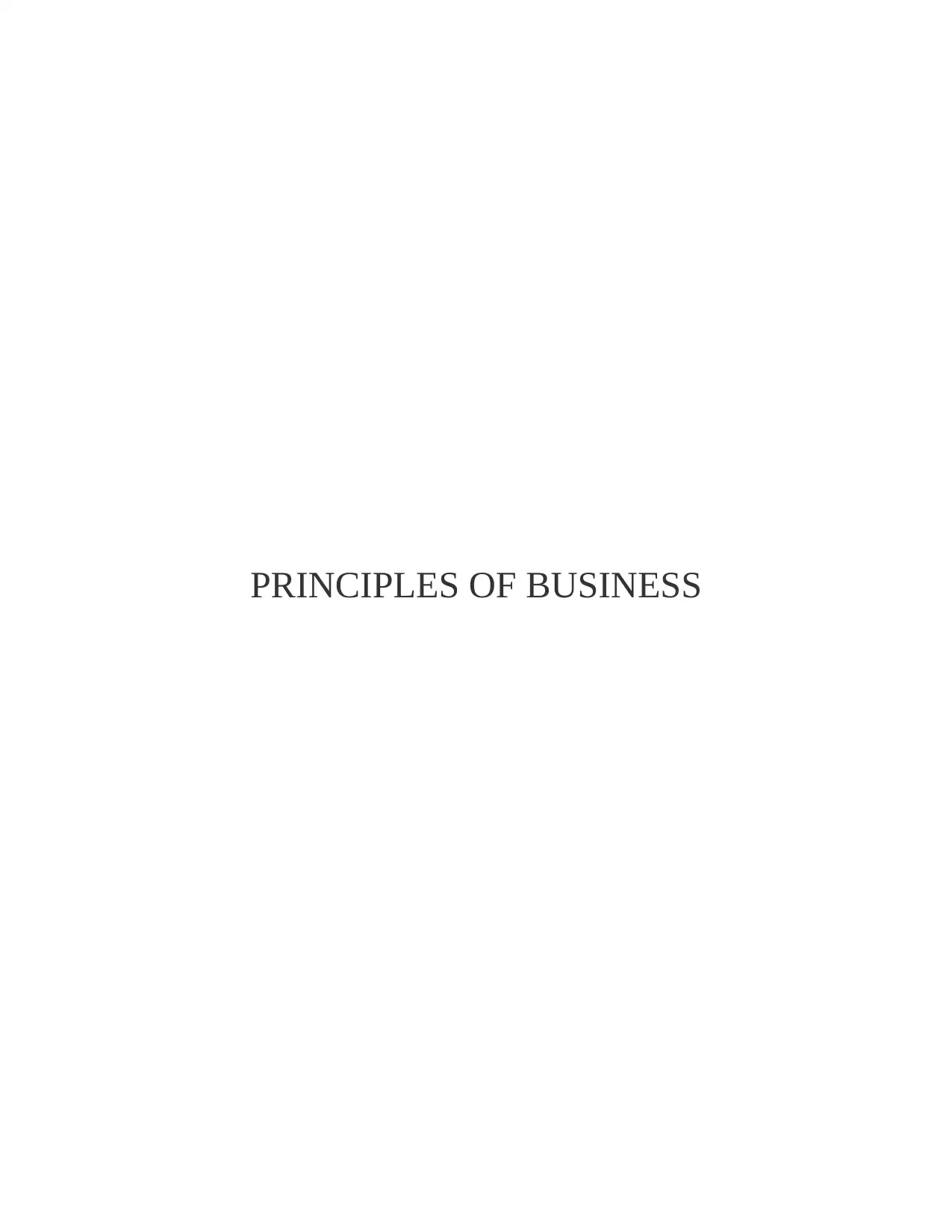
PRINCIPLES OF BUSINESS
Paraphrase This Document
Need a fresh take? Get an instant paraphrase of this document with our AI Paraphraser
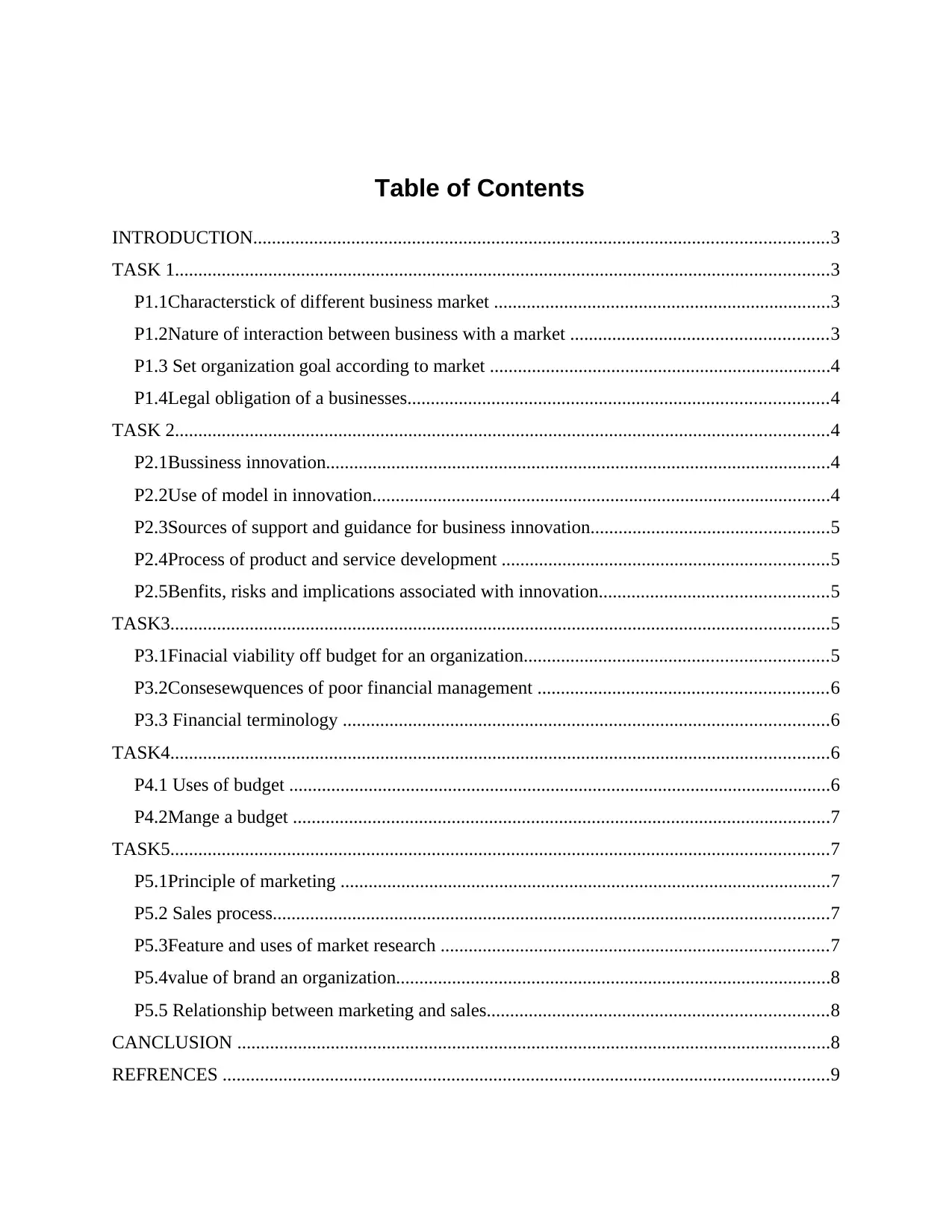
Table of Contents
INTRODUCTION...........................................................................................................................3
TASK 1............................................................................................................................................3
P1.1Characterstick of different business market ........................................................................3
P1.2Nature of interaction between business with a market .......................................................3
P1.3 Set organization goal according to market .........................................................................4
P1.4Legal obligation of a businesses..........................................................................................4
TASK 2............................................................................................................................................4
P2.1Bussiness innovation............................................................................................................4
P2.2Use of model in innovation..................................................................................................4
P2.3Sources of support and guidance for business innovation...................................................5
P2.4Process of product and service development ......................................................................5
P2.5Benfits, risks and implications associated with innovation.................................................5
TASK3.............................................................................................................................................5
P3.1Finacial viability off budget for an organization.................................................................5
P3.2Consesewquences of poor financial management ..............................................................6
P3.3 Financial terminology ........................................................................................................6
TASK4.............................................................................................................................................6
P4.1 Uses of budget ....................................................................................................................6
P4.2Mange a budget ...................................................................................................................7
TASK5.............................................................................................................................................7
P5.1Principle of marketing .........................................................................................................7
P5.2 Sales process.......................................................................................................................7
P5.3Feature and uses of market research ...................................................................................7
P5.4value of brand an organization.............................................................................................8
P5.5 Relationship between marketing and sales.........................................................................8
CANCLUSION ...............................................................................................................................8
REFRENCES ..................................................................................................................................9
INTRODUCTION...........................................................................................................................3
TASK 1............................................................................................................................................3
P1.1Characterstick of different business market ........................................................................3
P1.2Nature of interaction between business with a market .......................................................3
P1.3 Set organization goal according to market .........................................................................4
P1.4Legal obligation of a businesses..........................................................................................4
TASK 2............................................................................................................................................4
P2.1Bussiness innovation............................................................................................................4
P2.2Use of model in innovation..................................................................................................4
P2.3Sources of support and guidance for business innovation...................................................5
P2.4Process of product and service development ......................................................................5
P2.5Benfits, risks and implications associated with innovation.................................................5
TASK3.............................................................................................................................................5
P3.1Finacial viability off budget for an organization.................................................................5
P3.2Consesewquences of poor financial management ..............................................................6
P3.3 Financial terminology ........................................................................................................6
TASK4.............................................................................................................................................6
P4.1 Uses of budget ....................................................................................................................6
P4.2Mange a budget ...................................................................................................................7
TASK5.............................................................................................................................................7
P5.1Principle of marketing .........................................................................................................7
P5.2 Sales process.......................................................................................................................7
P5.3Feature and uses of market research ...................................................................................7
P5.4value of brand an organization.............................................................................................8
P5.5 Relationship between marketing and sales.........................................................................8
CANCLUSION ...............................................................................................................................8
REFRENCES ..................................................................................................................................9
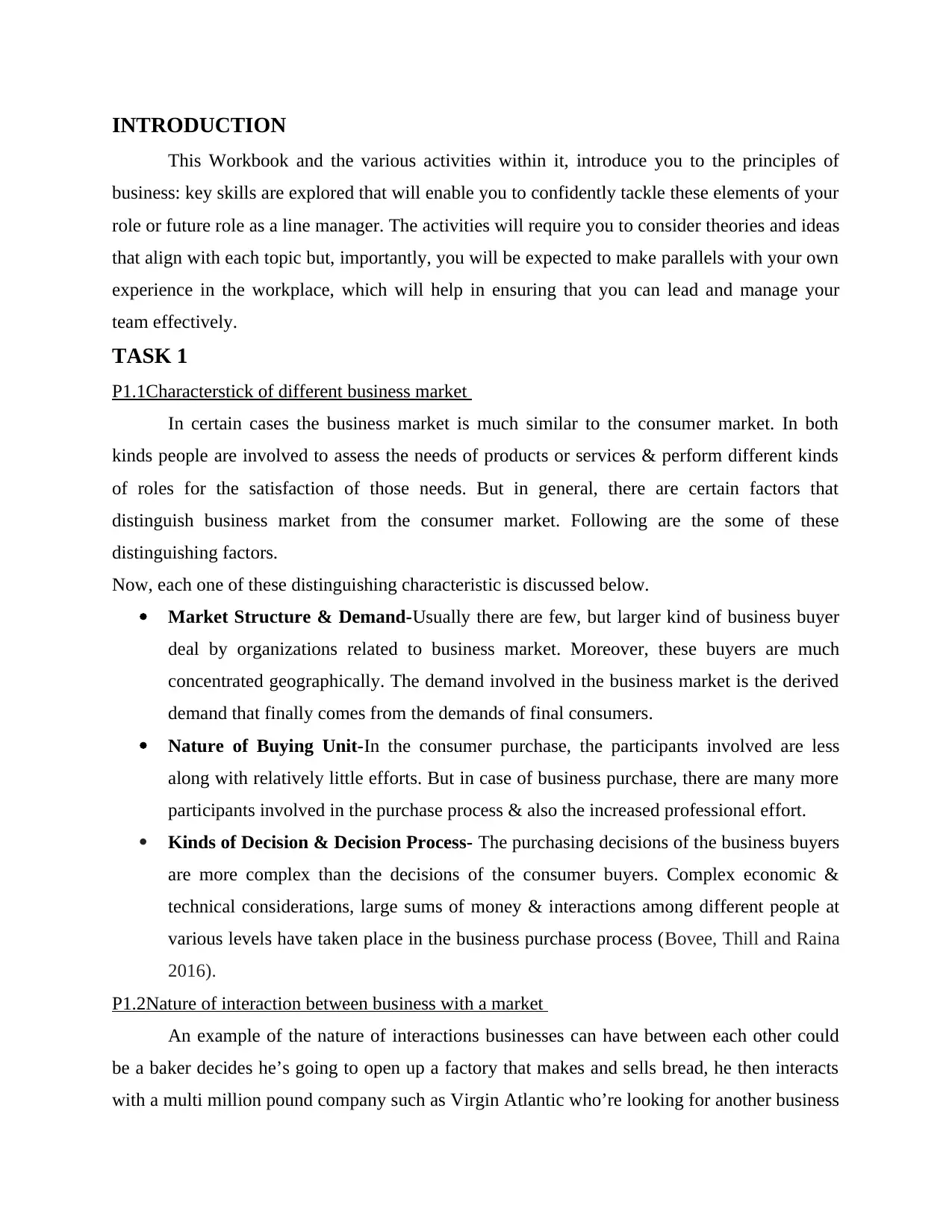
INTRODUCTION
This Workbook and the various activities within it, introduce you to the principles of
business: key skills are explored that will enable you to confidently tackle these elements of your
role or future role as a line manager. The activities will require you to consider theories and ideas
that align with each topic but, importantly, you will be expected to make parallels with your own
experience in the workplace, which will help in ensuring that you can lead and manage your
team effectively.
TASK 1
P1.1Characterstick of different business market
In certain cases the business market is much similar to the consumer market. In both
kinds people are involved to assess the needs of products or services & perform different kinds
of roles for the satisfaction of those needs. But in general, there are certain factors that
distinguish business market from the consumer market. Following are the some of these
distinguishing factors.
Now, each one of these distinguishing characteristic is discussed below.
Market Structure & Demand-Usually there are few, but larger kind of business buyer
deal by organizations related to business market. Moreover, these buyers are much
concentrated geographically. The demand involved in the business market is the derived
demand that finally comes from the demands of final consumers.
Nature of Buying Unit-In the consumer purchase, the participants involved are less
along with relatively little efforts. But in case of business purchase, there are many more
participants involved in the purchase process & also the increased professional effort.
Kinds of Decision & Decision Process- The purchasing decisions of the business buyers
are more complex than the decisions of the consumer buyers. Complex economic &
technical considerations, large sums of money & interactions among different people at
various levels have taken place in the business purchase process (Bovee, Thill and Raina
2016).
P1.2Nature of interaction between business with a market
An example of the nature of interactions businesses can have between each other could
be a baker decides he’s going to open up a factory that makes and sells bread, he then interacts
with a multi million pound company such as Virgin Atlantic who’re looking for another business
This Workbook and the various activities within it, introduce you to the principles of
business: key skills are explored that will enable you to confidently tackle these elements of your
role or future role as a line manager. The activities will require you to consider theories and ideas
that align with each topic but, importantly, you will be expected to make parallels with your own
experience in the workplace, which will help in ensuring that you can lead and manage your
team effectively.
TASK 1
P1.1Characterstick of different business market
In certain cases the business market is much similar to the consumer market. In both
kinds people are involved to assess the needs of products or services & perform different kinds
of roles for the satisfaction of those needs. But in general, there are certain factors that
distinguish business market from the consumer market. Following are the some of these
distinguishing factors.
Now, each one of these distinguishing characteristic is discussed below.
Market Structure & Demand-Usually there are few, but larger kind of business buyer
deal by organizations related to business market. Moreover, these buyers are much
concentrated geographically. The demand involved in the business market is the derived
demand that finally comes from the demands of final consumers.
Nature of Buying Unit-In the consumer purchase, the participants involved are less
along with relatively little efforts. But in case of business purchase, there are many more
participants involved in the purchase process & also the increased professional effort.
Kinds of Decision & Decision Process- The purchasing decisions of the business buyers
are more complex than the decisions of the consumer buyers. Complex economic &
technical considerations, large sums of money & interactions among different people at
various levels have taken place in the business purchase process (Bovee, Thill and Raina
2016).
P1.2Nature of interaction between business with a market
An example of the nature of interactions businesses can have between each other could
be a baker decides he’s going to open up a factory that makes and sells bread, he then interacts
with a multi million pound company such as Virgin Atlantic who’re looking for another business
⊘ This is a preview!⊘
Do you want full access?
Subscribe today to unlock all pages.

Trusted by 1+ million students worldwide
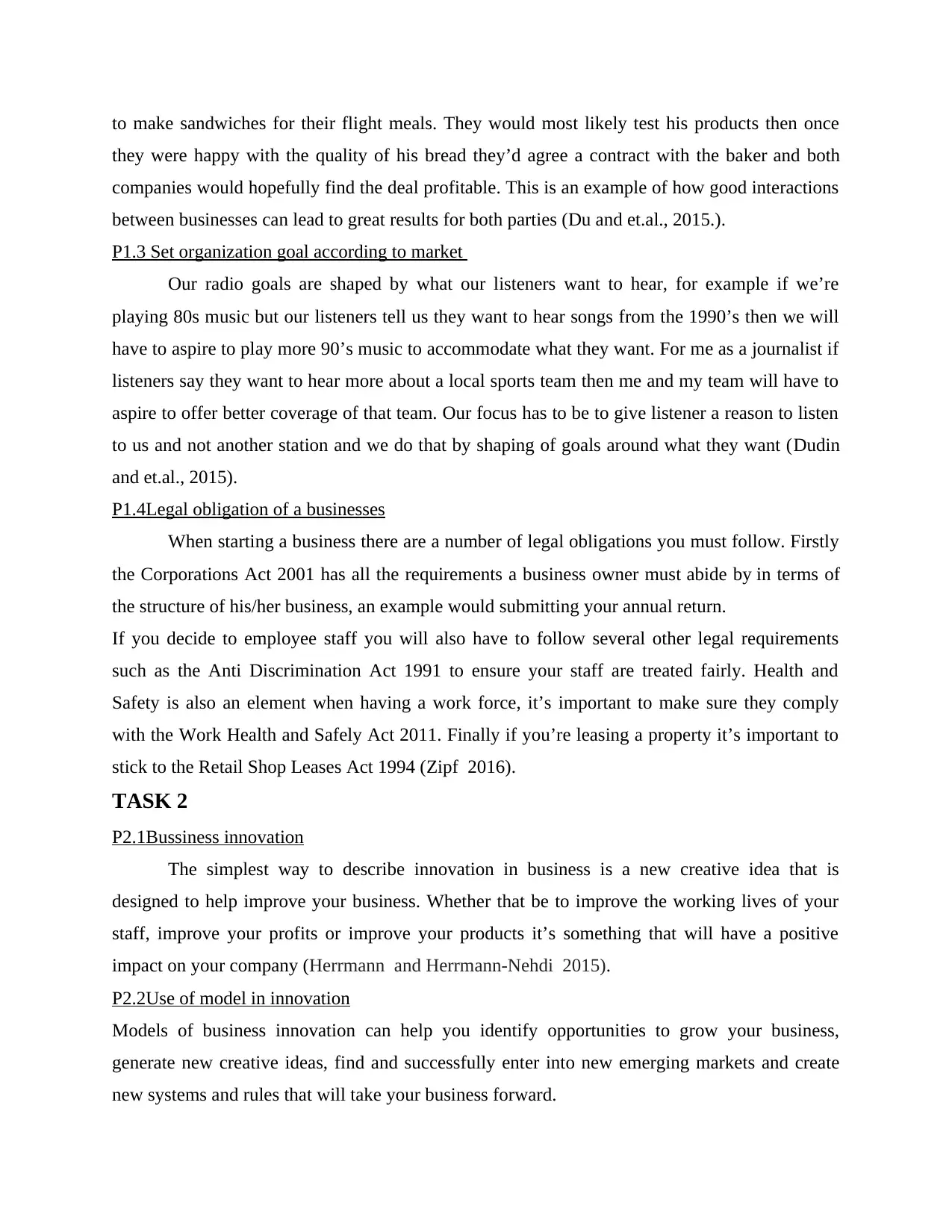
to make sandwiches for their flight meals. They would most likely test his products then once
they were happy with the quality of his bread they’d agree a contract with the baker and both
companies would hopefully find the deal profitable. This is an example of how good interactions
between businesses can lead to great results for both parties (Du and et.al., 2015.).
P1.3 Set organization goal according to market
Our radio goals are shaped by what our listeners want to hear, for example if we’re
playing 80s music but our listeners tell us they want to hear songs from the 1990’s then we will
have to aspire to play more 90’s music to accommodate what they want. For me as a journalist if
listeners say they want to hear more about a local sports team then me and my team will have to
aspire to offer better coverage of that team. Our focus has to be to give listener a reason to listen
to us and not another station and we do that by shaping of goals around what they want (Dudin
and et.al., 2015).
P1.4Legal obligation of a businesses
When starting a business there are a number of legal obligations you must follow. Firstly
the Corporations Act 2001 has all the requirements a business owner must abide by in terms of
the structure of his/her business, an example would submitting your annual return.
If you decide to employee staff you will also have to follow several other legal requirements
such as the Anti Discrimination Act 1991 to ensure your staff are treated fairly. Health and
Safety is also an element when having a work force, it’s important to make sure they comply
with the Work Health and Safely Act 2011. Finally if you’re leasing a property it’s important to
stick to the Retail Shop Leases Act 1994 (Zipf 2016).
TASK 2
P2.1Bussiness innovation
The simplest way to describe innovation in business is a new creative idea that is
designed to help improve your business. Whether that be to improve the working lives of your
staff, improve your profits or improve your products it’s something that will have a positive
impact on your company (Herrmann and Herrmann-Nehdi 2015).
P2.2Use of model in innovation
Models of business innovation can help you identify opportunities to grow your business,
generate new creative ideas, find and successfully enter into new emerging markets and create
new systems and rules that will take your business forward.
they were happy with the quality of his bread they’d agree a contract with the baker and both
companies would hopefully find the deal profitable. This is an example of how good interactions
between businesses can lead to great results for both parties (Du and et.al., 2015.).
P1.3 Set organization goal according to market
Our radio goals are shaped by what our listeners want to hear, for example if we’re
playing 80s music but our listeners tell us they want to hear songs from the 1990’s then we will
have to aspire to play more 90’s music to accommodate what they want. For me as a journalist if
listeners say they want to hear more about a local sports team then me and my team will have to
aspire to offer better coverage of that team. Our focus has to be to give listener a reason to listen
to us and not another station and we do that by shaping of goals around what they want (Dudin
and et.al., 2015).
P1.4Legal obligation of a businesses
When starting a business there are a number of legal obligations you must follow. Firstly
the Corporations Act 2001 has all the requirements a business owner must abide by in terms of
the structure of his/her business, an example would submitting your annual return.
If you decide to employee staff you will also have to follow several other legal requirements
such as the Anti Discrimination Act 1991 to ensure your staff are treated fairly. Health and
Safety is also an element when having a work force, it’s important to make sure they comply
with the Work Health and Safely Act 2011. Finally if you’re leasing a property it’s important to
stick to the Retail Shop Leases Act 1994 (Zipf 2016).
TASK 2
P2.1Bussiness innovation
The simplest way to describe innovation in business is a new creative idea that is
designed to help improve your business. Whether that be to improve the working lives of your
staff, improve your profits or improve your products it’s something that will have a positive
impact on your company (Herrmann and Herrmann-Nehdi 2015).
P2.2Use of model in innovation
Models of business innovation can help you identify opportunities to grow your business,
generate new creative ideas, find and successfully enter into new emerging markets and create
new systems and rules that will take your business forward.
Paraphrase This Document
Need a fresh take? Get an instant paraphrase of this document with our AI Paraphraser
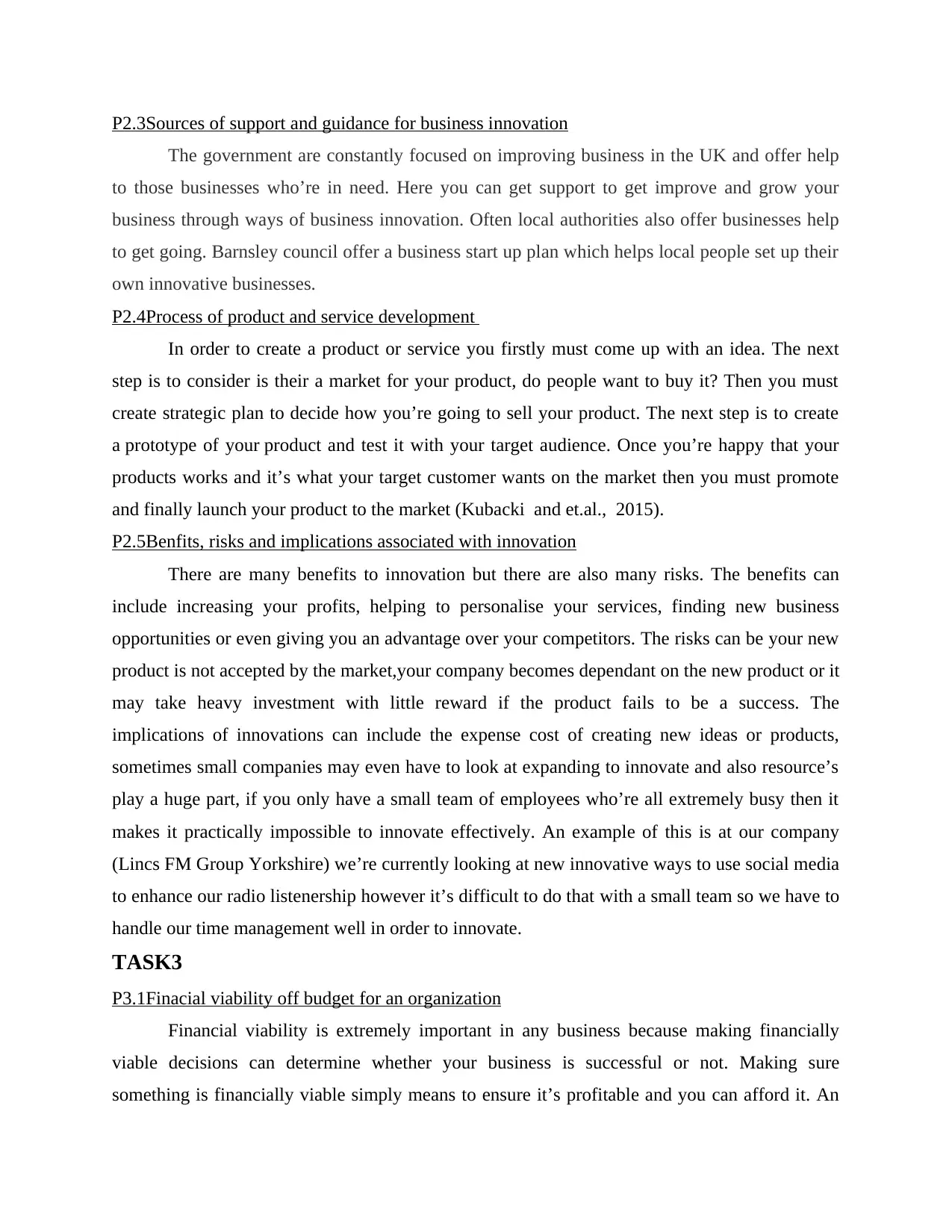
P2.3Sources of support and guidance for business innovation
The government are constantly focused on improving business in the UK and offer help
to those businesses who’re in need. Here you can get support to get improve and grow your
business through ways of business innovation. Often local authorities also offer businesses help
to get going. Barnsley council offer a business start up plan which helps local people set up their
own innovative businesses.
P2.4Process of product and service development
In order to create a product or service you firstly must come up with an idea. The next
step is to consider is their a market for your product, do people want to buy it? Then you must
create strategic plan to decide how you’re going to sell your product. The next step is to create
a prototype of your product and test it with your target audience. Once you’re happy that your
products works and it’s what your target customer wants on the market then you must promote
and finally launch your product to the market (Kubacki and et.al., 2015).
P2.5Benfits, risks and implications associated with innovation
There are many benefits to innovation but there are also many risks. The benefits can
include increasing your profits, helping to personalise your services, finding new business
opportunities or even giving you an advantage over your competitors. The risks can be your new
product is not accepted by the market,your company becomes dependant on the new product or it
may take heavy investment with little reward if the product fails to be a success. The
implications of innovations can include the expense cost of creating new ideas or products,
sometimes small companies may even have to look at expanding to innovate and also resource’s
play a huge part, if you only have a small team of employees who’re all extremely busy then it
makes it practically impossible to innovate effectively. An example of this is at our company
(Lincs FM Group Yorkshire) we’re currently looking at new innovative ways to use social media
to enhance our radio listenership however it’s difficult to do that with a small team so we have to
handle our time management well in order to innovate.
TASK3
P3.1Finacial viability off budget for an organization
Financial viability is extremely important in any business because making financially
viable decisions can determine whether your business is successful or not. Making sure
something is financially viable simply means to ensure it’s profitable and you can afford it. An
The government are constantly focused on improving business in the UK and offer help
to those businesses who’re in need. Here you can get support to get improve and grow your
business through ways of business innovation. Often local authorities also offer businesses help
to get going. Barnsley council offer a business start up plan which helps local people set up their
own innovative businesses.
P2.4Process of product and service development
In order to create a product or service you firstly must come up with an idea. The next
step is to consider is their a market for your product, do people want to buy it? Then you must
create strategic plan to decide how you’re going to sell your product. The next step is to create
a prototype of your product and test it with your target audience. Once you’re happy that your
products works and it’s what your target customer wants on the market then you must promote
and finally launch your product to the market (Kubacki and et.al., 2015).
P2.5Benfits, risks and implications associated with innovation
There are many benefits to innovation but there are also many risks. The benefits can
include increasing your profits, helping to personalise your services, finding new business
opportunities or even giving you an advantage over your competitors. The risks can be your new
product is not accepted by the market,your company becomes dependant on the new product or it
may take heavy investment with little reward if the product fails to be a success. The
implications of innovations can include the expense cost of creating new ideas or products,
sometimes small companies may even have to look at expanding to innovate and also resource’s
play a huge part, if you only have a small team of employees who’re all extremely busy then it
makes it practically impossible to innovate effectively. An example of this is at our company
(Lincs FM Group Yorkshire) we’re currently looking at new innovative ways to use social media
to enhance our radio listenership however it’s difficult to do that with a small team so we have to
handle our time management well in order to innovate.
TASK3
P3.1Finacial viability off budget for an organization
Financial viability is extremely important in any business because making financially
viable decisions can determine whether your business is successful or not. Making sure
something is financially viable simply means to ensure it’s profitable and you can afford it. An
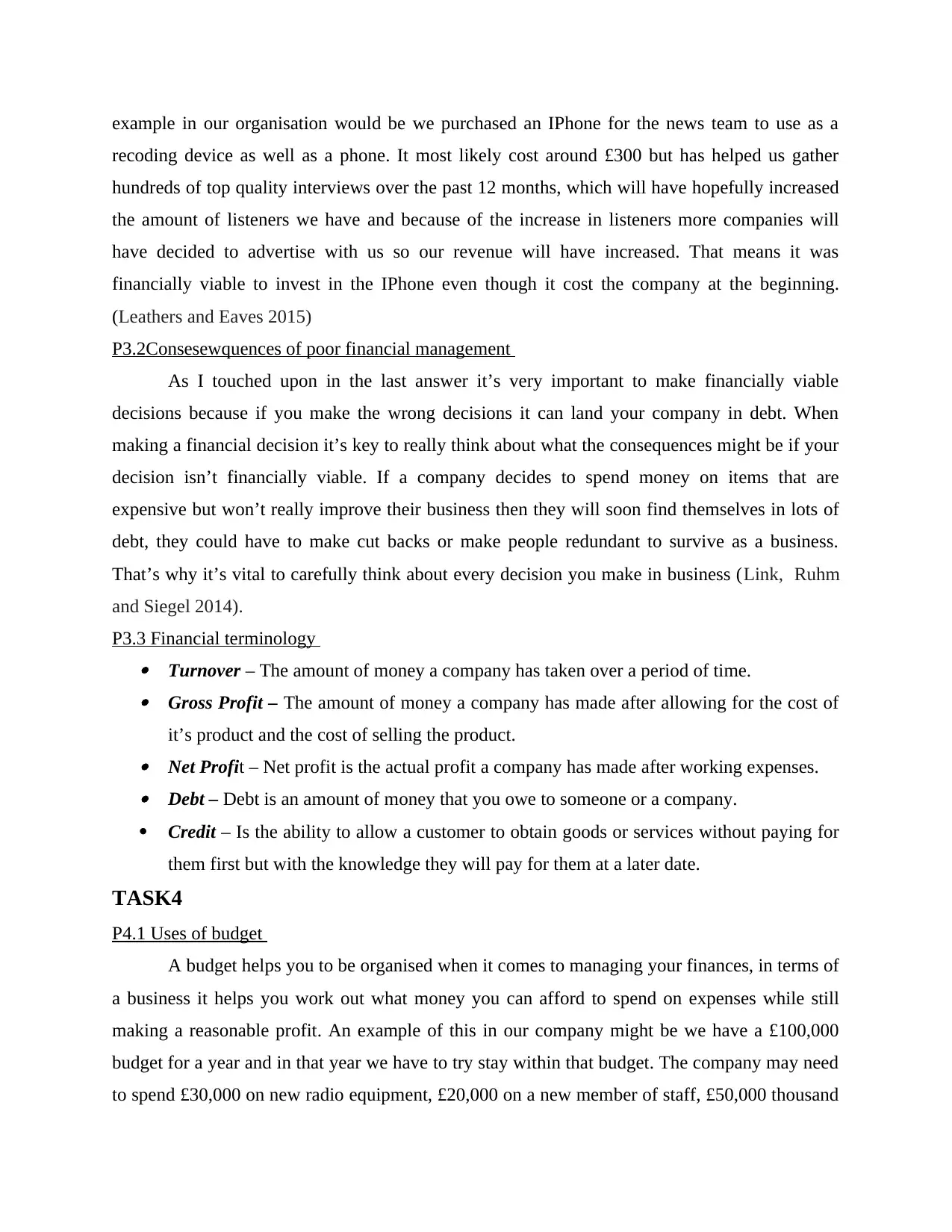
example in our organisation would be we purchased an IPhone for the news team to use as a
recoding device as well as a phone. It most likely cost around £300 but has helped us gather
hundreds of top quality interviews over the past 12 months, which will have hopefully increased
the amount of listeners we have and because of the increase in listeners more companies will
have decided to advertise with us so our revenue will have increased. That means it was
financially viable to invest in the IPhone even though it cost the company at the beginning.
(Leathers and Eaves 2015)
P3.2Consesewquences of poor financial management
As I touched upon in the last answer it’s very important to make financially viable
decisions because if you make the wrong decisions it can land your company in debt. When
making a financial decision it’s key to really think about what the consequences might be if your
decision isn’t financially viable. If a company decides to spend money on items that are
expensive but won’t really improve their business then they will soon find themselves in lots of
debt, they could have to make cut backs or make people redundant to survive as a business.
That’s why it’s vital to carefully think about every decision you make in business (Link, Ruhm
and Siegel 2014).
P3.3 Financial terminology Turnover – The amount of money a company has taken over a period of time. Gross Profit – The amount of money a company has made after allowing for the cost of
it’s product and the cost of selling the product. Net Profit – Net profit is the actual profit a company has made after working expenses. Debt – Debt is an amount of money that you owe to someone or a company.
Credit – Is the ability to allow a customer to obtain goods or services without paying for
them first but with the knowledge they will pay for them at a later date.
TASK4
P4.1 Uses of budget
A budget helps you to be organised when it comes to managing your finances, in terms of
a business it helps you work out what money you can afford to spend on expenses while still
making a reasonable profit. An example of this in our company might be we have a £100,000
budget for a year and in that year we have to try stay within that budget. The company may need
to spend £30,000 on new radio equipment, £20,000 on a new member of staff, £50,000 thousand
recoding device as well as a phone. It most likely cost around £300 but has helped us gather
hundreds of top quality interviews over the past 12 months, which will have hopefully increased
the amount of listeners we have and because of the increase in listeners more companies will
have decided to advertise with us so our revenue will have increased. That means it was
financially viable to invest in the IPhone even though it cost the company at the beginning.
(Leathers and Eaves 2015)
P3.2Consesewquences of poor financial management
As I touched upon in the last answer it’s very important to make financially viable
decisions because if you make the wrong decisions it can land your company in debt. When
making a financial decision it’s key to really think about what the consequences might be if your
decision isn’t financially viable. If a company decides to spend money on items that are
expensive but won’t really improve their business then they will soon find themselves in lots of
debt, they could have to make cut backs or make people redundant to survive as a business.
That’s why it’s vital to carefully think about every decision you make in business (Link, Ruhm
and Siegel 2014).
P3.3 Financial terminology Turnover – The amount of money a company has taken over a period of time. Gross Profit – The amount of money a company has made after allowing for the cost of
it’s product and the cost of selling the product. Net Profit – Net profit is the actual profit a company has made after working expenses. Debt – Debt is an amount of money that you owe to someone or a company.
Credit – Is the ability to allow a customer to obtain goods or services without paying for
them first but with the knowledge they will pay for them at a later date.
TASK4
P4.1 Uses of budget
A budget helps you to be organised when it comes to managing your finances, in terms of
a business it helps you work out what money you can afford to spend on expenses while still
making a reasonable profit. An example of this in our company might be we have a £100,000
budget for a year and in that year we have to try stay within that budget. The company may need
to spend £30,000 on new radio equipment, £20,000 on a new member of staff, £50,000 thousand
⊘ This is a preview!⊘
Do you want full access?
Subscribe today to unlock all pages.

Trusted by 1+ million students worldwide
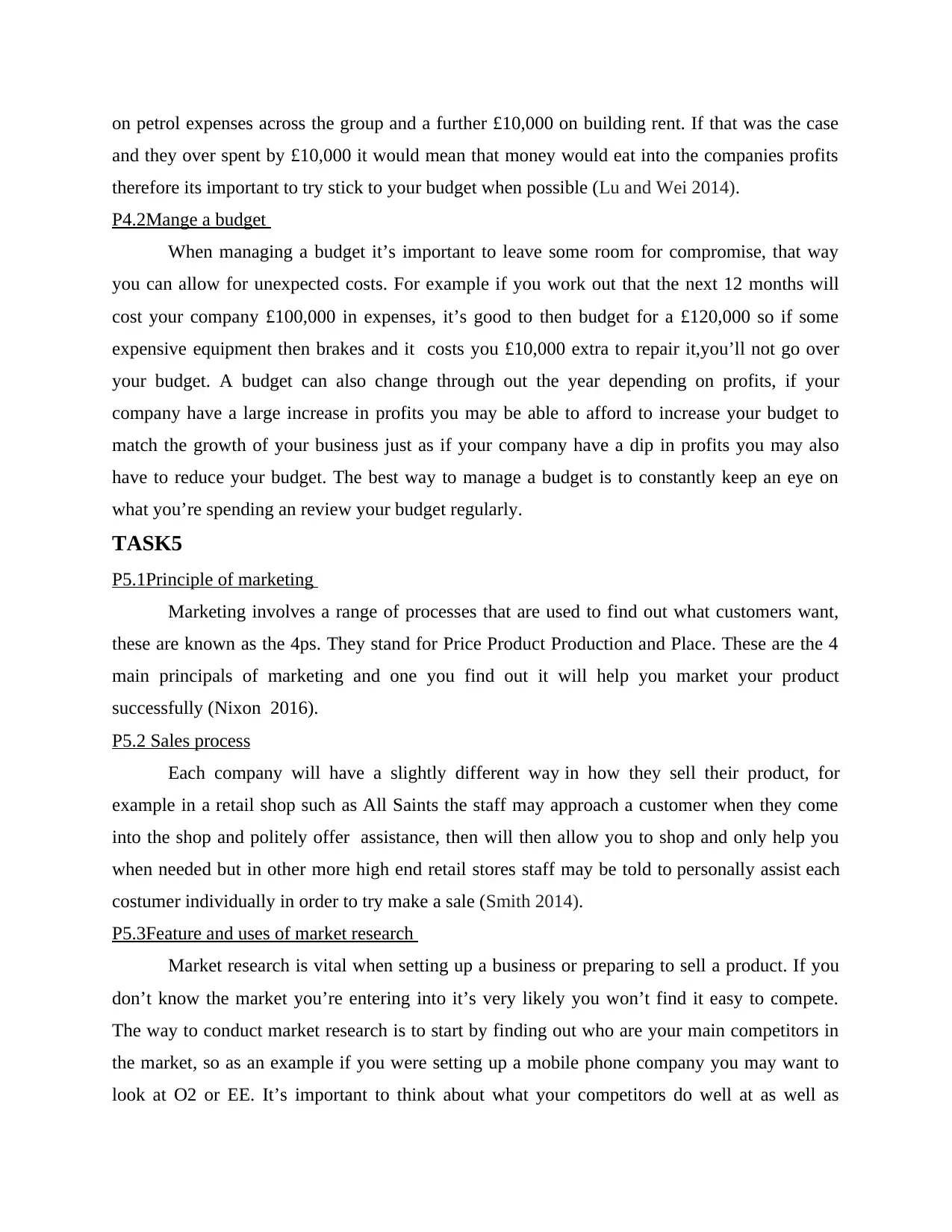
on petrol expenses across the group and a further £10,000 on building rent. If that was the case
and they over spent by £10,000 it would mean that money would eat into the companies profits
therefore its important to try stick to your budget when possible (Lu and Wei 2014).
P4.2Mange a budget
When managing a budget it’s important to leave some room for compromise, that way
you can allow for unexpected costs. For example if you work out that the next 12 months will
cost your company £100,000 in expenses, it’s good to then budget for a £120,000 so if some
expensive equipment then brakes and it costs you £10,000 extra to repair it,you’ll not go over
your budget. A budget can also change through out the year depending on profits, if your
company have a large increase in profits you may be able to afford to increase your budget to
match the growth of your business just as if your company have a dip in profits you may also
have to reduce your budget. The best way to manage a budget is to constantly keep an eye on
what you’re spending an review your budget regularly.
TASK5
P5.1Principle of marketing
Marketing involves a range of processes that are used to find out what customers want,
these are known as the 4ps. They stand for Price Product Production and Place. These are the 4
main principals of marketing and one you find out it will help you market your product
successfully (Nixon 2016).
P5.2 Sales process
Each company will have a slightly different way in how they sell their product, for
example in a retail shop such as All Saints the staff may approach a customer when they come
into the shop and politely offer assistance, then will then allow you to shop and only help you
when needed but in other more high end retail stores staff may be told to personally assist each
costumer individually in order to try make a sale (Smith 2014).
P5.3Feature and uses of market research
Market research is vital when setting up a business or preparing to sell a product. If you
don’t know the market you’re entering into it’s very likely you won’t find it easy to compete.
The way to conduct market research is to start by finding out who are your main competitors in
the market, so as an example if you were setting up a mobile phone company you may want to
look at O2 or EE. It’s important to think about what your competitors do well at as well as
and they over spent by £10,000 it would mean that money would eat into the companies profits
therefore its important to try stick to your budget when possible (Lu and Wei 2014).
P4.2Mange a budget
When managing a budget it’s important to leave some room for compromise, that way
you can allow for unexpected costs. For example if you work out that the next 12 months will
cost your company £100,000 in expenses, it’s good to then budget for a £120,000 so if some
expensive equipment then brakes and it costs you £10,000 extra to repair it,you’ll not go over
your budget. A budget can also change through out the year depending on profits, if your
company have a large increase in profits you may be able to afford to increase your budget to
match the growth of your business just as if your company have a dip in profits you may also
have to reduce your budget. The best way to manage a budget is to constantly keep an eye on
what you’re spending an review your budget regularly.
TASK5
P5.1Principle of marketing
Marketing involves a range of processes that are used to find out what customers want,
these are known as the 4ps. They stand for Price Product Production and Place. These are the 4
main principals of marketing and one you find out it will help you market your product
successfully (Nixon 2016).
P5.2 Sales process
Each company will have a slightly different way in how they sell their product, for
example in a retail shop such as All Saints the staff may approach a customer when they come
into the shop and politely offer assistance, then will then allow you to shop and only help you
when needed but in other more high end retail stores staff may be told to personally assist each
costumer individually in order to try make a sale (Smith 2014).
P5.3Feature and uses of market research
Market research is vital when setting up a business or preparing to sell a product. If you
don’t know the market you’re entering into it’s very likely you won’t find it easy to compete.
The way to conduct market research is to start by finding out who are your main competitors in
the market, so as an example if you were setting up a mobile phone company you may want to
look at O2 or EE. It’s important to think about what your competitors do well at as well as
Paraphrase This Document
Need a fresh take? Get an instant paraphrase of this document with our AI Paraphraser
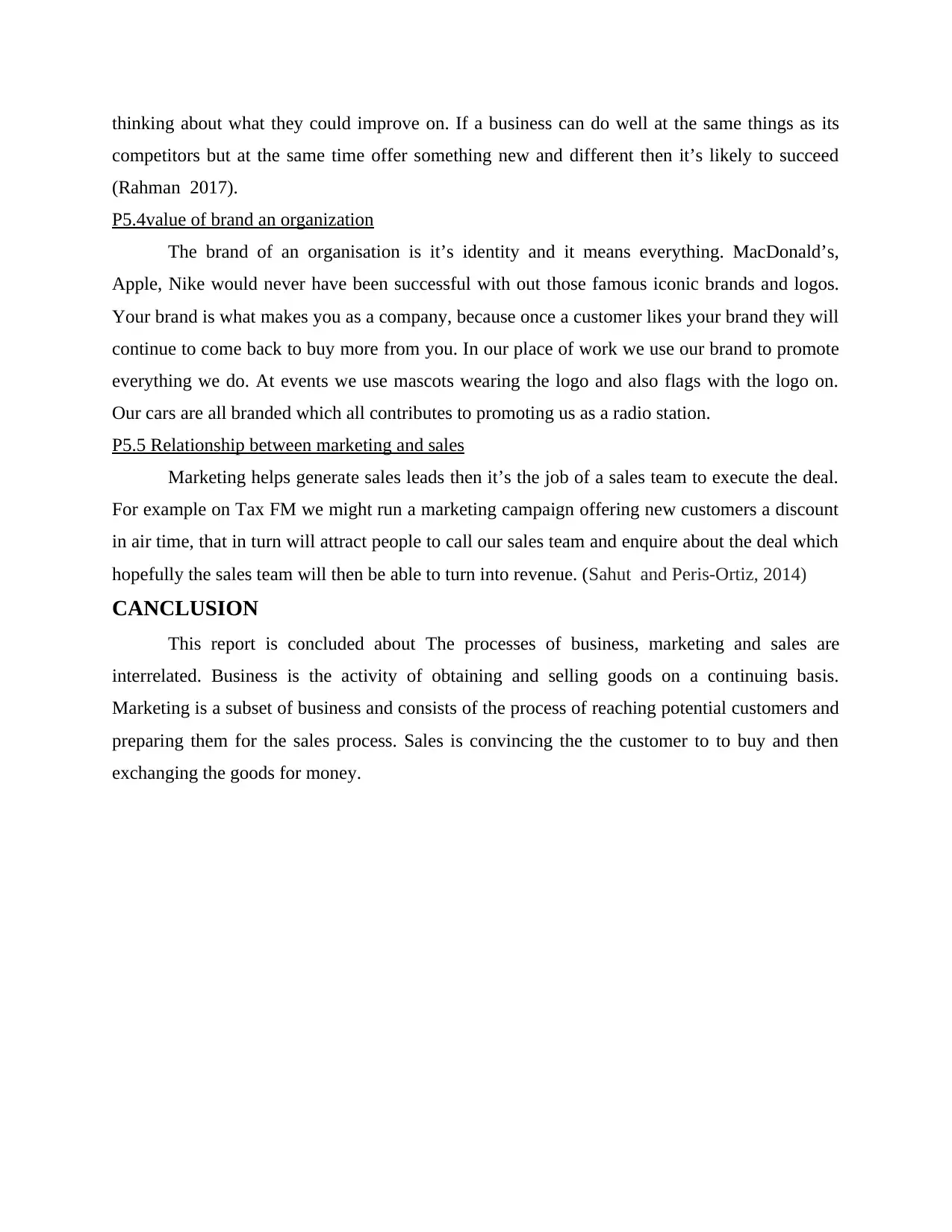
thinking about what they could improve on. If a business can do well at the same things as its
competitors but at the same time offer something new and different then it’s likely to succeed
(Rahman 2017).
P5.4value of brand an organization
The brand of an organisation is it’s identity and it means everything. MacDonald’s,
Apple, Nike would never have been successful with out those famous iconic brands and logos.
Your brand is what makes you as a company, because once a customer likes your brand they will
continue to come back to buy more from you. In our place of work we use our brand to promote
everything we do. At events we use mascots wearing the logo and also flags with the logo on.
Our cars are all branded which all contributes to promoting us as a radio station.
P5.5 Relationship between marketing and sales
Marketing helps generate sales leads then it’s the job of a sales team to execute the deal.
For example on Tax FM we might run a marketing campaign offering new customers a discount
in air time, that in turn will attract people to call our sales team and enquire about the deal which
hopefully the sales team will then be able to turn into revenue. (Sahut and Peris-Ortiz, 2014)
CANCLUSION
This report is concluded about The processes of business, marketing and sales are
interrelated. Business is the activity of obtaining and selling goods on a continuing basis.
Marketing is a subset of business and consists of the process of reaching potential customers and
preparing them for the sales process. Sales is convincing the the customer to to buy and then
exchanging the goods for money.
competitors but at the same time offer something new and different then it’s likely to succeed
(Rahman 2017).
P5.4value of brand an organization
The brand of an organisation is it’s identity and it means everything. MacDonald’s,
Apple, Nike would never have been successful with out those famous iconic brands and logos.
Your brand is what makes you as a company, because once a customer likes your brand they will
continue to come back to buy more from you. In our place of work we use our brand to promote
everything we do. At events we use mascots wearing the logo and also flags with the logo on.
Our cars are all branded which all contributes to promoting us as a radio station.
P5.5 Relationship between marketing and sales
Marketing helps generate sales leads then it’s the job of a sales team to execute the deal.
For example on Tax FM we might run a marketing campaign offering new customers a discount
in air time, that in turn will attract people to call our sales team and enquire about the deal which
hopefully the sales team will then be able to turn into revenue. (Sahut and Peris-Ortiz, 2014)
CANCLUSION
This report is concluded about The processes of business, marketing and sales are
interrelated. Business is the activity of obtaining and selling goods on a continuing basis.
Marketing is a subset of business and consists of the process of reaching potential customers and
preparing them for the sales process. Sales is convincing the the customer to to buy and then
exchanging the goods for money.
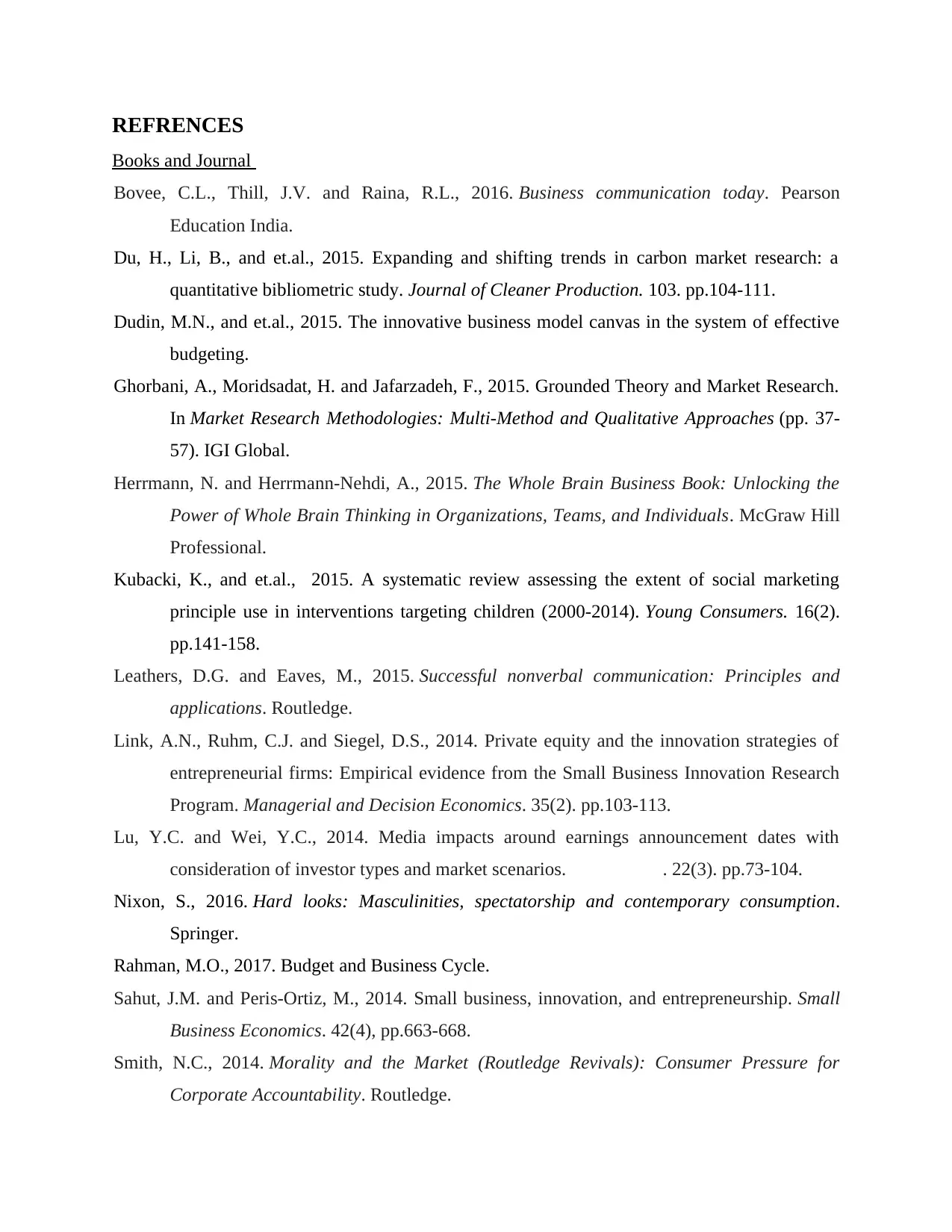
REFRENCES
Books and Journal
Bovee, C.L., Thill, J.V. and Raina, R.L., 2016. Business communication today. Pearson
Education India.
Du, H., Li, B., and et.al., 2015. Expanding and shifting trends in carbon market research: a
quantitative bibliometric study. Journal of Cleaner Production. 103. pp.104-111.
Dudin, M.N., and et.al., 2015. The innovative business model canvas in the system of effective
budgeting.
Ghorbani, A., Moridsadat, H. and Jafarzadeh, F., 2015. Grounded Theory and Market Research.
In Market Research Methodologies: Multi-Method and Qualitative Approaches (pp. 37-
57). IGI Global.
Herrmann, N. and Herrmann-Nehdi, A., 2015. The Whole Brain Business Book: Unlocking the
Power of Whole Brain Thinking in Organizations, Teams, and Individuals. McGraw Hill
Professional.
Kubacki, K., and et.al., 2015. A systematic review assessing the extent of social marketing
principle use in interventions targeting children (2000-2014). Young Consumers. 16(2).
pp.141-158.
Leathers, D.G. and Eaves, M., 2015. Successful nonverbal communication: Principles and
applications. Routledge.
Link, A.N., Ruhm, C.J. and Siegel, D.S., 2014. Private equity and the innovation strategies of
entrepreneurial firms: Empirical evidence from the Small Business Innovation Research
Program. Managerial and Decision Economics. 35(2). pp.103-113.
Lu, Y.C. and Wei, Y.C., 2014. Media impacts around earnings announcement dates with
consideration of investor types and market scenarios. 財財財財財財 . 22(3). pp.73-104.
Nixon, S., 2016. Hard looks: Masculinities, spectatorship and contemporary consumption.
Springer.
Rahman, M.O., 2017. Budget and Business Cycle.
Sahut, J.M. and Peris-Ortiz, M., 2014. Small business, innovation, and entrepreneurship. Small
Business Economics. 42(4), pp.663-668.
Smith, N.C., 2014. Morality and the Market (Routledge Revivals): Consumer Pressure for
Corporate Accountability. Routledge.
Books and Journal
Bovee, C.L., Thill, J.V. and Raina, R.L., 2016. Business communication today. Pearson
Education India.
Du, H., Li, B., and et.al., 2015. Expanding and shifting trends in carbon market research: a
quantitative bibliometric study. Journal of Cleaner Production. 103. pp.104-111.
Dudin, M.N., and et.al., 2015. The innovative business model canvas in the system of effective
budgeting.
Ghorbani, A., Moridsadat, H. and Jafarzadeh, F., 2015. Grounded Theory and Market Research.
In Market Research Methodologies: Multi-Method and Qualitative Approaches (pp. 37-
57). IGI Global.
Herrmann, N. and Herrmann-Nehdi, A., 2015. The Whole Brain Business Book: Unlocking the
Power of Whole Brain Thinking in Organizations, Teams, and Individuals. McGraw Hill
Professional.
Kubacki, K., and et.al., 2015. A systematic review assessing the extent of social marketing
principle use in interventions targeting children (2000-2014). Young Consumers. 16(2).
pp.141-158.
Leathers, D.G. and Eaves, M., 2015. Successful nonverbal communication: Principles and
applications. Routledge.
Link, A.N., Ruhm, C.J. and Siegel, D.S., 2014. Private equity and the innovation strategies of
entrepreneurial firms: Empirical evidence from the Small Business Innovation Research
Program. Managerial and Decision Economics. 35(2). pp.103-113.
Lu, Y.C. and Wei, Y.C., 2014. Media impacts around earnings announcement dates with
consideration of investor types and market scenarios. 財財財財財財 . 22(3). pp.73-104.
Nixon, S., 2016. Hard looks: Masculinities, spectatorship and contemporary consumption.
Springer.
Rahman, M.O., 2017. Budget and Business Cycle.
Sahut, J.M. and Peris-Ortiz, M., 2014. Small business, innovation, and entrepreneurship. Small
Business Economics. 42(4), pp.663-668.
Smith, N.C., 2014. Morality and the Market (Routledge Revivals): Consumer Pressure for
Corporate Accountability. Routledge.
⊘ This is a preview!⊘
Do you want full access?
Subscribe today to unlock all pages.

Trusted by 1+ million students worldwide

Zipf, G.K., 2016. Human behavior and the principle of least effort: An introduction to human
ecology. Ravenio Books.
ecology. Ravenio Books.
1 out of 10
Related Documents
Your All-in-One AI-Powered Toolkit for Academic Success.
+13062052269
info@desklib.com
Available 24*7 on WhatsApp / Email
![[object Object]](/_next/static/media/star-bottom.7253800d.svg)
Unlock your academic potential
Copyright © 2020–2025 A2Z Services. All Rights Reserved. Developed and managed by ZUCOL.




